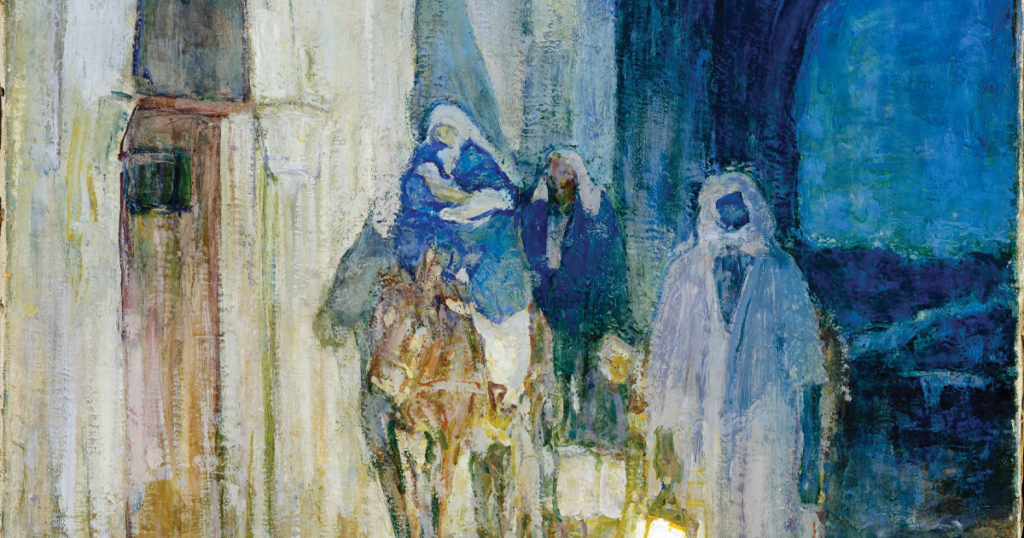The Miracle Amid the Scandals of Christmas
"Let us provide a witness to the world that Love came down at Christmas, and that the gift of salvation is available to all who will accept the Christ Child as the Savior of the world."
The Christmas story is usually recounted in glowing terms of peace and joy, of angels and shepherds, of wise men and a star. But the fact is that there were scandals connected to that history-changing event—scandals that cannot be overlooked, scandals that impacted the Nativity, scandals that affect us today.
The first scandal was that a woman was married and didn’t have a baby! In our 21st century, such a situation would hardly be noticed. It wouldn’t cause gossiping tongues to wag. It wouldn’t be thought unusual. But in ancient Judea, it was calamitous.
Married women were expected to produce offspring. Having children was seen as both an obligation and a blessing. Even more important, motherhood was regarded as evidence that the parents were honoring God—and being honored by Him. “Children are a heritage from the Lord, offspring a reward from him” says the well-known 127th Psalm (v.3 NIV), one of the hymns sung frequently by pilgrims as they approached the city of Jerusalem.
To be childless was just the opposite. For a married woman to be barren in first-century Israel was an indication that somehow God was not pleased with her. Not only did she feel abandoned by God; often she was shunned by her neighbors.
Such a woman was Elizabeth, wife of Zechariah, a priest. Luke, the gospel writer, tells us that “both of them were upright in the sight of God, observing all of the Lord’s commands and decrees blamelessly” (1:6).
Luke continues, “But they were childless because Elizabeth was not able to conceive, and they were both very old” (v.7). For decades, they had hoped, longed and prayed for a son or daughter, with no positive result.
Then God intervened. Elizabeth became pregnant and, in due time, she delivered a son who would be known as John the Baptist. The scandal, for her, was over.
The second scandal of Christmas concerns not a married woman without a baby, but an unmarried maiden with a baby. Again, the gospel of Luke gives us the details. A carpenter in Nazareth named Joseph was engaged to a young woman named Mary. Although the actual wedding ceremony had not taken place, they were legally bound to each other—so much so that a divorce ceremony would have been required to nullify the relationship.
Mary had been visited by an angel, who revealed that she would miraculously become pregnant without having a sexual relationship with a man. The angel explained further that her pregnancy would be affected by God, the Holy Spirit, and that her offspring would be called the Son of God.
The news, of course, was incredibly startling. But Mary trusted both the angel and the Almighty who had sent him. “I am the Lord’s servant,” she answered. “May your word to me be fulfilled” (1:38).
If Mary was at peace with the arrangement, Joseph certainly was not. He faced a dilemma. He could expose Mary as an expectant mother, which might very well lead to her execution by stoning. The Old Testament law was specific: “If a man commits adultery with another man’s wife—with the wife of his neighbor—both the adulterer and the adulteress must be put to death” (Leviticus 20:10).
But Joseph loved Mary. As an alternative, he considered a quiet divorce. Perhaps both of them could leave Nazareth. That would not prevent gossip in the streets, but at least they would be alive and safe—and far from their inquisitive neighbors.
Happily, Joseph, like Mary, was visited by an angel. The heavenly visitor explained that “What is conceived in her is from the Holy Spirit. She will give birth to a son, and you are to give him the name Jesus, because he will save his people from their sins” (Matthew 1:20-22).
What the angels had foretold came true. The Christ Child was born. He grew in wisdom and in stature. For three years, He ministered to the sick, lonely and outcast, as well as the learned and religious leaders. He taught His followers to love God and their neighbor, to serve rather than desiring to be served, to worship God in spirit and in truth.
Then He was crucified.
And therein lies the third scandal of the Christmas season. He gave His very life as an atonement for the sins of His people, Israel, and for the whole world. But instead of being accepted, He was rejected. “He came to that which was his own, and his own did not receive him” (John 1:11). Instead, Jesus, as foretold by the Prophet Isaiah, was “despised and rejected by mankind, a man of sorrows and familiar with pain” (Isaiah 53:3).
Jesus gave up the splendors of Glory in order to take on human flesh, the Creator identifying with the creation. Not only did He provide a flawless example of how to live, He opened the way for sinful men and women to be reconciled with God. His contemporaries, with few exceptions, turned their backs on Him. And in today’s world, He is often rejected, more often ignored.
By His suffering and death at Calvary, Jesus made an atonement for the whole world. But the vast majority, throughout the ages and even to this present day, have failed to accept His atoning work. Divine Light came into a darkened world, “But people loved darkness instead of light because their deeds were evil” (John 3:19).
During this holy season, may each of us avoid the scandal of unbelief and rejection. May we allow the Savior to be born anew in our own hearts, making us new creatures in Jesus Christ. Then let us provide a witness to the world that Love came down at Christmas, and that the gift of salvation is available to all who will accept the Christ Child as the Savior of the world.
Commissioner Robert E. Thomson whose articles appear periodically in the War Cry, lives in retirement in Clearwater, FL.







